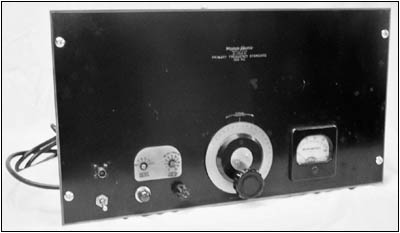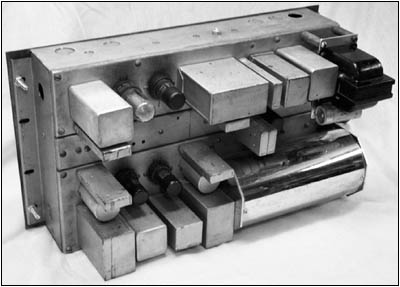Of Old Radios And Related Items--Published Monthly
Western Electric Primary Frequency Standard
BY WALTER H. HALL
Web Edition
In general, old test equipment is not as widely collected, or as valuable, as old radios. But, restoring old test equipment and putting it to work can be a rewarding experience. In this article, Walter Hall describes how he restored a high quality piece of Western Electric test equipment. (Editor)
A number of years ago I acquired an interesting piece of equipment with a nomenclature that indicated that it was intended to be the major part of a system functionally equivalent to existing Primary Frequency Standards used by industry for many years for frequency reference purposes. This unit was made by Western Electric and designated Primary Frequency Standard 100 Kc D-151231. The basic unit, shown in Figure 1, consists of a heavy (38 pounds) steel box and components appropriate to a signal generating device. It is 19 inches wide, 101/2 inches high and 8 inches deep and is suitable for mounting in a standard 19-inch relay rack.

Figure 1. A front view of the Western Electric Primary Frequency Standard shows the controls and connectors, including the precision tuning dial and meter.Construction
The general construction details are the typical Western Electric style of the earlier period. The front panel is removable for access to the interior. However, the panel is not similar to the then usual Western Electric designs, which use a flat steel panel with an attached plate identifying the unit and indicating a serial number and model number. This unit departs from the usual Western Electric product in that the front panel is thicker than usual and was designed so that the identifying nomenclature and part number, along with a peripheral frame, are raised above the panel by approximately 1/32 inch, by what appears to have been an etching process.
For operational purposes, the front panel includes a Weston 100 microampere meter, a precision tuning dial for minor frequency corrections, a screw driver-operated rotary switch for larger incremental corrections and a similar type of switch for measuring plate currents of the vacuum tubes and the output level of the generated signal. Since this type of device is intended to be operational for long periods of time, the panel controls were essential to assure that performance had not deteriorated and to enable documentation of daily performance.
A rear view of the unit is shown in Figures 2 and 3 (see print version). The frequency standard uses four Type 6AC7 tubes and one Type 6V6GT. The large chrome-plated shield can at the lower left houses the crystal oven. It contains a 100 Kc crystal and thermostatically controlled heating elements. It measures approximately 4 inches in diameter and 81/2 inches long.
Making It Work
With such an impressive nomenclature and also with a Western Electric label, this unit seemed worth the time to take any actions necessary to make it operational. Since it lacked a power supply, one had to be built. Fortunately, there is a small unoccupied space in the rear of the unit, so a compact AC-powered supply of conventional design was made to fit the space and to satisfy the power requirements. The added power supply can be seen in the upper right corner of Figure 3.

Figure 2. A rear view of the Frequency Standard shows the neatly arranged components and tubes. The crystal oven is the shiny chrome-plated device in the lower right.I realized at the time that the addition of a nonstandard power supply could change its potentially museum-quality status forever; however, since my goal was to make it a useful working unit if possible, I proceeded, regardless of the consequences.
While the power supply worked very satisfactorily, the unit refused to function. Investigation of internal wiring disclosed evidence of previous efforts. Since specific technical data was not available, the investigation was based largely on visual examination and point-to-point testing. Because the internal wiring was principally of small diameter, shielded-wire circuit tracing was difficult since the short exposed ends of the wire had lost their original color codes over the years.
To facilitate testing, I found it necessary to employ a 5-volt, 1000-cycle signal applied to terminal points and a signal tracer to find the other end of the wires. This enabled investigation of all circuits and ultimately located the faulty circuit. After I had corrected the fault, the 100 Kc oscillator started functioning and ultimately provided an output of 1.05 volts at a frequency of 100,000.7 cycles, in short-term tests.
Since the unit now satisfied my operational objective, I included a few changes to satisfy some of today's standards. These were a 3- conductor power cord, a pilot light, a switch, a fuse holder and a BNC connector for the output.
When operational, the unit also emitted a measurable sound found to be 570 cycles. This sound was from the output transformer for the 6V6GT electron tube. Further exploration identified the sound as the output of a separate oscillator which functioned as the power source for the crystal oven heaters. The heaters were deemed to be functioning adequately since the crystal oven became slightly warm to the touch (100 degrees F).
A Later Model -- The D-175730
My search for specific technical information on the D-151231 was unsuccessful. I did, however, obtain some useful information pertaining to a later model, the D-175730, which was somewhat similar -- same tube line-up -- but otherwise, significantly different.
It is of interest to note that while the D-151231 was identified as a "Primary Frequency Standard," the D-175730 was identified as a "Frequency Standard Crystal Oscillator." It would appear that the more stringent requirements for a Primary Standard may have been abandoned as an impractical goal at that time. The fact that the D-151231 had no conventional WE nameplate or serial number could suggest that it was a prototype engineering model.
The later model included other refinements intended to improve frequency stability and also used more of Western Electric's established mechanical design features. In addition, it included a name plate and serial number typical of the WE product line.
Regardless of its uncertain history, the D-151231 represents a level of technical expertise commensurate with those challenging times when there were still many unexplored areas in the field of electronics. For practical reasons, a device designed to provide accurate frequencies at 100 Kc is mostly of historic interest in today's technology. Nevertheless, I am sure that the D-151231 was seriously intended to be an important Western Electric product and is possibly one of the few ever built.
(Walter H. Hall, 405 Ludlow Ave., Spring Lake, NJ 07762)
Walter Hall has been a longtime collector of electronic test equipment, some old, some newer. He has a large collection of restored items related to much earlier times and continues to seek new candidates. The WE item was of particular interest because of the unusual aspect of its origin.
| [Free Sample] [Books, etc., For Sale] [Subscribe to A.R.C./Renew] [Classified Ads] [Auction Prices] [Event Calendar] [Links] [Home] [Issue Archives] [Book Reviews] [Subscription Information] [A.R.C. FAQ] URL = http://www.antiqueradio.com/May05_Hall_Standard.html Copyright © 1996-2005 by John V. Terrey - For personal use only. Last revised: April 24, 2005. For Customer Assistance please contact ARC@antiqueradio.com or call (866) 371-0512 toll free Pages designed/maintained by Wayward Fluffy Publications
Antique Radio Classified |